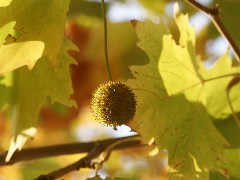London Plane Tree
Platanus x hispanicaFamily: Platanaceae
script
London Plane Trees |
London Plane Tree Bark |
London Plane Tree Leaf |
 London Plane Tree Seed Pod www.wikipedia.com |
Classification:
- Angiosperm, Dicot, deciduousSize:
- 60-100 ft. tall- 80 ft. spread
Identifying Features:
The bark, which sloughs (sheds) as the plant gets older, has an interesting mosaic pattern of olive green, cream, and light brown. The leaves are large (6-7" long and up to 10" across) and maple-like, with 3-5 lobes per leaf. In the autumn the leaves, which turn yellowish to brown, along with shed twigs and seed balls, can create quite a mess on the ground around the tree. Ball shaped yellow or brown seed clusters hang on threadlike stalks through winter. The trunk is tall, heavy, and strait with upright and spreading branches, forming an overall rounded shape.Location/Habitat:
Although best in deep, moist, fertile soil, one can find the very adaptable London Plane Tree in almost any habitat, as they grow well under a variety of conditions:- Deciduous
- Clay, Loam, or Sand
- Highly acidic to highly alkaline soil
Flower/Fruit/Reproduction:
Prized in winter arrangements, the London Plane Tree's seeds are grouped in small ball-shaped clusters that hang from bare branches on slender, thread-like stalks throughout the winter. Blooming in April, the London Plane Tree is monoecious, with male and female flowers separated. The flowers have no ornamental purpose for attracting pollinators. The fruit is about 1" in diameter and is borne in twos and threes. Propagation can occur through both cuttings and seeds.Water/Sun Requirements:
Again, the London Plane Tree is found in a large range of conditions- Moderate to regular water (wet to dry soil)
- Full sun to partial shade
Special Adaptations:
The London Plane Tree is more resistant (although still subject) to sycamore anthracnose. It is however, susceptible to powdery mildew, sycamore lacebug, and the American plum borer.Other Info:
- Commonly mistaken as a normal sycamore, the London Plane Tree is a cross between the American sycamore and the Oriental planetree
- Growth Rate: 36 inches per season
- Longevity: 150+ years, but often cut short by disease
- High biogenic emissions
- Relatively strong branches, especially for such a fast growing tree
- Easily transplanted